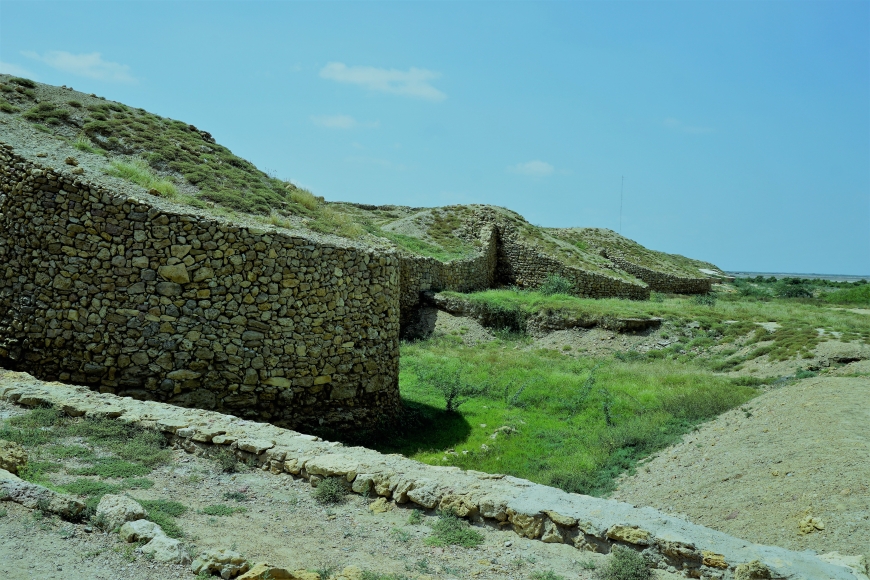Main Info
The Archaeological Site of Banbhore is situated 64 kilometers south-east of Karachi on the bank of Gharo Creek in District Thatta, Sindh province of Pakistan. Banbhore is an early Islamic Archaeological site which has a sequence from 1st century BC to 13th Century AD. Whilst its earlier phases are waterlogged, the surface remains of the site represent the best preserved early Islamic urban form in South Asia. It is also the region’s best preserved medieval port. Lying on the mouth of an old channel of mighty Indus, the site is ideally situated to have been an inland port of some importance which scholars describe as DEBAL, the famous port which fall to the Arab General Muhammad Bin Qasim in 712 A.D, due to incident which led to this first conquest of Islam in the sub-continent. As per historical records few Arab ships were carrying Muslim ladies and gifts from Ceylon to the Caliph were robbed while stationed at Debal. Similar incident occurred before this, and Arab shipping in the coastal area was disturbed by the local pirates. Failing to get any redress for such activities from the ruling King Raja Dahir, Hajjaj bin Yousf, the Governor of the Eastern province of the Umayyad caliphate, sent two small punitive expeditions which were not successful. The last one under Muhammad Bin Qasim entered Dahir’s Kingdom after crossing the Hab River, and gave shattering blow to this power at Debal in 712 A.D within three years the whole country of Sindh was conquered and Muslim rule was established.
First excavation at site was started in March 1958 which continued for about seven years up to 1965. The yester year’s excavation shows the site conceals the remains of a settlement of considerable size. The port’s plan consists of five main zones. The most impressive zone is a 10 m high mound which stands on the shore of the creek itself. Measuring 610 m by 305 m, the mound is delineated by a 3m wide limestone fortification wall with 46 rounded bastions and 3 gates. The latter appears to be connected to a grid iron arrangement of streets. An interior wall divides the mound into western and eastern sectors, with the floor plans of major structures preserved on the surface of the latter half. These largest structures have been identified as a mosque, an administrative quarter and a serai or inn.
The ground plan of its stone-built mosque is particularly well preserved and consisted of a square plane, measuring 34m by 35m with a central open courtyard, surrounded by cloisters. The western cloister formed the prayer hall and its flat roof was supported by 33 wooden pillars, resting on sandstone bases.
There was no trace of a mehrab, but an inscription dating 727 AD (15 years after the conquest of Sindh by Arab General Muhammad Ibn-e-Qasim) indicates that this is the best preserved example of an early mosque in the region, while others having rebuilt. The evidence of the reuse of carved stone from earlier Hindu structures suggests that the site had undergone a major shift in cultural and ritual focus. Beyond the walls, there are two substantial but unfortified suburbs to the eastern and the north-eastern corners. There exists a large artificial tank or reservoir — the port’s drinking supply — and a large industrial area that stretches along the latter’s western edge with evidence of textile processing, glass-making, glazing, and metallurgy industries. The presence of the industrial sector and the port’s wealth of imported ceramic and metal goods, in combination with its strategic setting at the mouth of the mighty Indus River, reinforce the pivotal role of Banbhore linking the international Indian Ocean traders with the resources of the interior of Sindh / South Asia. Its role ended when the Indus shifted its course in 11th Century AD and the creek silted up, underlying the role that nature has played in shaping the heritage.
Site & Museum Timings
09:00 AM to 05:00 PM
Open seven days a week
Tickets
Locals: Rs 50
Foreigners: Rs 1500 (USD 5 $)
Child: Rs 30
Rest House Charges
Single Room Rs.2500/
Double Room Rs. 5000/
Virtual Tour:
Banbhore Museum










